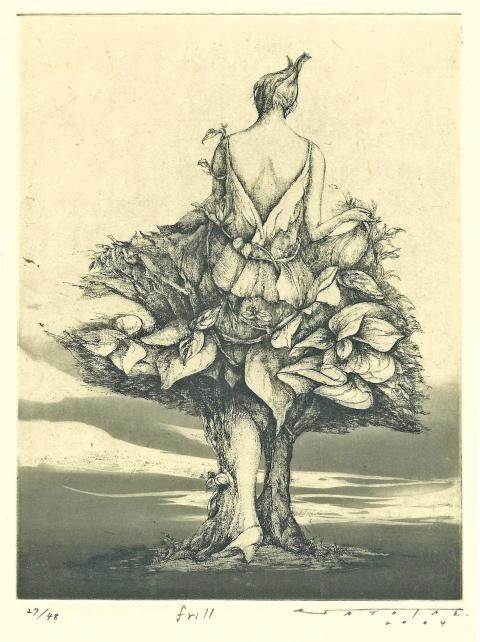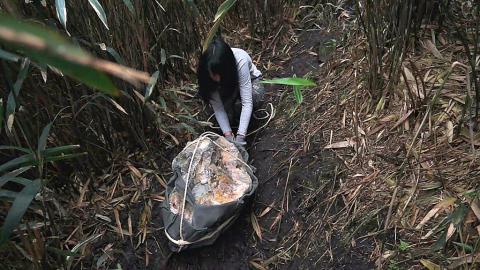The printmaking arts and crafts shop MBMore is currently exhibiting Aura: Young Japanese Artists’ Print Exhibition (日本青年藝術家9人展), an exhibition by nine Japanese artists. The works on display range from delicate etchings of birds perched on trees to dainty ladies dressed in frilly, feathered ensembles. It’s one of MBMore’s more modest exhibitions, with each piece of artwork being the roughly size of a small greeting card. However, in an era where digital art and giant-sized installations are being trumpeted, it’s refreshing to see old techniques such as woodblock prints and etchings still being used by young artists. The artworks also add to the shop’s homely vibe.
■ MBMore (岩筆模), 32-1, Chifeng St, Taipei City (台北市赤峰街32-1號); tel: (02) 2558-3395. Open Tuesday to Sundays from 1pm to 9pm
■ Until Jan. 17

Photo courtesy of MBMore
Beitou (北投) today is known for its natural hot springs and resorts where lovebirds go to canoodle. But if you’re a history buff, you’ll notice the signs around Thermal Valley (地熱谷) explaining the how sulfur — a property said to make your skin as smooth as a baby’s — came to be found in the area. Fascinated by this history, artist Yu Ji (于吉) created a series of videos, sculptures and installations tracing its discovery in Beitou (also known as Pataauw) for her latest exhibition at Mind Set Art Center, entitled Diary of Sulfur Mining — Pataauw (採硫日記 — 上卷). Her work conjures the sense of the thrill from an archaeological discovery or scientific expedition while still managing to be artistically minimalistic. Also, be sure to see if you can smell the sulfur in some of Yu’s sculptures.
■ Mind Set Art Center (安卓藝術), 16-1, Xinsheng S Rd Sec 3, Taipei City (台北市新生南路三段16-1號), tel: (02) 2365-6008. Open Tuesdays to Sundays from 2pm to 6pm
■ Until Jan. 24

Photo courtesy of Lin & Lin Gallery
Huang Pei-Ju’s (黃珮如) colorful, splotchy paintings and Christophe Prat’s dreamy, pastel hues complement one another perfectly in their latest exhibition, Deja Vu, which opens at Galleria H tomorrow. Seen from afar, Huang’s paintings resemble ink blotches, but from up close, cityscapes and the silhouettes of people become visible. The Paris-born Prat uses a similar color palette, though his paintings, by contrast, are more minimalistic, consisting of single-color squares and rectangles. While Huang’s work serves to befuddle the viewer and make them ponder inquisitively, Prat’s work has a rather calming effect instead.
■ Galleria H (恆畫廊), 12-1, Ln 58, Xinsheng S Rd, Taipei City (台北市新生南路一段58巷12-1號), tel: (02) 3322-2553. Open Tuesdays to Sundays from 1pm to 7pm
■ Opens tomorrow. Until Jan. 31

Photo courtesy of Mind Set Art Center
When young Chinese artist Xie Fan (謝帆) made the switch from oil painting on canvas to oil painting on silk, some thought he was absolutely nuts (to say it’s difficult to paint on silk would be an understatement), while others thought the move was ingenious. Xie said he switched materials to better understand and preserve his heritage (of course), but the results are actually quite stunning. From billowing trees in dark forests to lush mountains peeking out from under layers of fog, Xie has managed to achieve a volume, depth and contrast between background and foreground that’s hard to achieve when painting on a surface as stubborn as silk. The simple scenes he depicts are as haunting as they are calming. Xie’s artwork can be seen on display starting tomorrow at Lin & Lin gallery in an exhibition entitled Xie Fan — One and A Half Years (謝帆 — 一年有半).
■ Lin & Lin Gallery (大未來林舍畫廊), 16 Dongfeng St, Taipei City (台北市東豐街16號), tel: (02) 2700-6866. Open Tuesdays to Sundays from 11am to 7pm
■ Opens tomorrow. Until Jan. 31
Japanese artist Hideki Kimura has been making waves in his country’s printmaking scene since the 1970s. Lately, he’s also been experimenting with painting on tiles, as well as filling entire gallery walls with lots of traditional-style fish motifs. Kimura’s style and palette spans a wide range, from opaque blues and grays to vibrant deep-red and gold hues. Kimura says of his tile paintings: “I think that it is disappearing, nothing.” Profound. His latest exhibition, Misty, which is held at Taipei’s Galerie Grand Siecle, includes a selection of his opaque, “disappearing” tile paintings.
■ Galerie Grand Siecle (新苑藝術), 17, Alley 51, Ln 12, Bade Rd Sec 3, Taipei City (台北市八德路三段12巷51弄17號), tel: (02) 2578-5630. Open Tuesdays to Sundays from 1pm to 6pm
■ Until Feb. 21

June 9 to June 15 A photo of two men riding trendy high-wheel Penny-Farthing bicycles past a Qing Dynasty gate aptly captures the essence of Taipei in 1897 — a newly colonized city on the cusp of great change. The Japanese began making significant modifications to the cityscape in 1899, tearing down Qing-era structures, widening boulevards and installing Western-style infrastructure and buildings. The photographer, Minosuke Imamura, only spent a year in Taiwan as a cartographer for the governor-general’s office, but he left behind a treasure trove of 130 images showing life at the onset of Japanese rule, spanning July 1897 to

One of the most important gripes that Taiwanese have about the Democratic Progressive Party (DPP) is that it has failed to deliver concretely on higher wages, housing prices and other bread-and-butter issues. The parallel complaint is that the DPP cares only about glamor issues, such as removing markers of Chinese Nationalist Party (KMT) colonialism by renaming them, or what the KMT codes as “de-Sinification.” Once again, as a critical election looms, the DPP is presenting evidence for that charge. The KMT was quick to jump on the recent proposal of the Ministry of the Interior (MOI) to rename roads that symbolize

On the evening of June 1, Control Yuan Secretary-General Lee Chun-yi (李俊俋) apologized and resigned in disgrace. His crime was instructing his driver to use a Control Yuan vehicle to transport his dog to a pet grooming salon. The Control Yuan is the government branch that investigates, audits and impeaches government officials for, among other things, misuse of government funds, so his misuse of a government vehicle was highly inappropriate. If this story were told to anyone living in the golden era of swaggering gangsters, flashy nouveau riche businessmen, and corrupt “black gold” politics of the 1980s and 1990s, they would have laughed.

In an interview posted online by United Daily News (UDN) on May 26, current Chinese Nationalist Party (KMT) Chairman Eric Chu (朱立倫) was asked about Taichung Mayor Lu Shiow-yen (盧秀燕) replacing him as party chair. Though not yet officially running, by the customs of Taiwan politics, Lu has been signalling she is both running for party chair and to be the party’s 2028 presidential candidate. She told an international media outlet that she was considering a run. She also gave a speech in Keelung on national priorities and foreign affairs. For details, see the May 23 edition of this column,